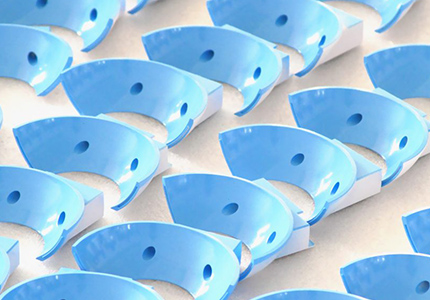Production grade parts with low-volume manufacturing and fast turnover
At Premium Parts, our urethane casting operations are best suited for prototyping high-quality parts with a wide variety of properties that accommodate design complexities. Vacuum casting is our low-volume production technique used to materialize the most intricate designs in production-grade materials without the need for hard tooling. Our cast urethane service is speedy, cost-effective, and scalable for a production of 20 to 100 units for prototyping and alternative applications. We also work with a range of materials from Elastomers, ABS, HDPE, PC to Acrylic-like to meet your application and specifications without compromising product quality. Work with us to accelerate your product development cycles and move from prototype to functional testing parts in as quickly as 48 hours.
What is Urethane Casting?
Urethane casting is a production molding technique where silicone molds and urethane (polyurethane) are used to form high-quality production-grade plastic parts. Also known as cast urethane, silicone molding, or RTV molding, urethane casting is an excellent production procedure used in rapid prototyping and batch manufacturing of parts at lower costs and speedier turnaround. The benefits of vacuum casting lie in cost and speed instead of expensive and time-consuming hard tooling associated with traditional manufacturing. With cast urethanes, molding is typically carried out with silicone. The mold is created through a master pattern from either the CNC machining or 3D printing, using liquid silicone to provide a high-accuracy simulation of finished products. This procedure is best suited for prototyping, and low volume production of parts for testing, market exhibition, or pilot runs.


Why Should You Use Urethane Casting?
At Premium Parts, we provide low-cost and rapid production alternatives that give our clients the ability to test finished products without investment in hard and expensive tooling. With great precision and consistency, cast urethane parts provide many advantages in product development cycles. Here are some key benefits as to why vacuum casting is an ideal process:
• Swift Turnaround
 Silicone, which is used as a mold tool, can be made in as fast as 48 hours. This lead time is relative to injection molds that could take weeks to produce. We satisfy customers looking for high-quality, low-volume production parts by giving them the advantage of having their products in reasonable quantities for functional testing long before hard tooling is completed. At Premium Parts, we have enhanced our urethane casting procedure to work across a wide variety of industries. In as little as 5-7 days, we can cast, finish, and ship your parts.
Silicone, which is used as a mold tool, can be made in as fast as 48 hours. This lead time is relative to injection molds that could take weeks to produce. We satisfy customers looking for high-quality, low-volume production parts by giving them the advantage of having their products in reasonable quantities for functional testing long before hard tooling is completed. At Premium Parts, we have enhanced our urethane casting procedure to work across a wide variety of industries. In as little as 5-7 days, we can cast, finish, and ship your parts.
 Vacuum casting is a more cost-effective solution for rapid prototyping and a small batch parts manufacturing. The cost of these silicone molds used in urethane casting is far more effective in price than expensive steel or aluminum tools used in injection molding. At Premium Parts, we provide urethane casting as a suitable alternative in situations where the cost of hard tooling would restrain production.
Vacuum casting is a more cost-effective solution for rapid prototyping and a small batch parts manufacturing. The cost of these silicone molds used in urethane casting is far more effective in price than expensive steel or aluminum tools used in injection molding. At Premium Parts, we provide urethane casting as a suitable alternative in situations where the cost of hard tooling would restrain production. 
Urethane casting is used to simulate a CNC machined master pattern. At Premium Parts, urethane casting tools are made from silicone rubber, which molds and gives accurate details, texture, and consistent finishes to suit end applications.
 With urethane casting, a high level of detail is achievable. Silicone molds can accurately mimic the texture and colors of production-grade parts to achieve designs for low-volume runs and prototypes. We also deliver custom finishes that allow you to customize the surface textures by painting the mold before the production process or painting end parts.
With urethane casting, a high level of detail is achievable. Silicone molds can accurately mimic the texture and colors of production-grade parts to achieve designs for low-volume runs and prototypes. We also deliver custom finishes that allow you to customize the surface textures by painting the mold before the production process or painting end parts.
 Our urethane casting procedure is detailed and perfect for rapid prototyping and low-volume demands in production-grade standard plastics and elastomers. This makes castings significantly stronger than their 3D-printed counterparts. At Premium Parts, cast urethane parts are made from impact-resistant and flexible engineering. We further improve your parts' quality with a vast line-up of finishes and treatment options available post-casting.
Our urethane casting procedure is detailed and perfect for rapid prototyping and low-volume demands in production-grade standard plastics and elastomers. This makes castings significantly stronger than their 3D-printed counterparts. At Premium Parts, cast urethane parts are made from impact-resistant and flexible engineering. We further improve your parts' quality with a vast line-up of finishes and treatment options available post-casting.
 We provide a wide variety of urethane cast materials that meets the needs of almost all applications. At Premium Parts, we have very soft and flexible to extremely rigid and impact-resistant materials. Urethane castings can adapt to high heat deflection and chemical resistance. Our resins have a wide range of properties, strength, and uses and can imitate patterns and properties of ABS, Nylon, PC, TPE, and Acrylic-like materials. The possibilities are many as they can be transparent, coated, colored, painted, and elastomeric.
We provide a wide variety of urethane cast materials that meets the needs of almost all applications. At Premium Parts, we have very soft and flexible to extremely rigid and impact-resistant materials. Urethane castings can adapt to high heat deflection and chemical resistance. Our resins have a wide range of properties, strength, and uses and can imitate patterns and properties of ABS, Nylon, PC, TPE, and Acrylic-like materials. The possibilities are many as they can be transparent, coated, colored, painted, and elastomeric.Our Urethane Casting Process
Premium Part's cast urethane services use a quality-driven process to achieve maximum quality and precision in our parts. Our vacuum process is a 4-step process summarized below:
• Step 1: Making the master pattern
Our urethane casting process begins with using computer-aided design to precision CNC machine a master pattern and printing the master pattern in either 3D printing SLS or SLA to provide a precise part that meets the master pattern's specifications.
• Step 2: Creation of Silicone mold
Casting molds made from liquid silicone are poured into a vacuum encasing the master pattern. Once the mold cures and solidifies, it is "surgically" cut into distinct halves, and the master pattern is removed, leaving a hollow cavity in the precision of the master pattern.
• Step 3: Manufacturing Parts
The cavity created after liquid silicone mold cures is used for casting the end product. Polyurethane resins are mixed and left to preheat about 40°C before use. The resins are poured into the mold in the vacuum chamber. It is then left in the oven for about 1-5 hours (depending on the size of parts) to cure. Once cured, the resin part is removed from the silicone mold tool, leaving an accurate and consistent copy. Silicone molds can make about 20 to 25 pieces, after which they should be replaced.
• Step 4: Final Finishes
This is the final step in the urethane casting process. Once cured, created prototypes can be cleaned, painted, polished, and coated as directed by clients to be made ready for the target market. The finishing process continues until the project is completed. Premium Parts provide high-quality parts with finishing and treatment options after the production of your urethane casting parts.
Our Urethane Casting Materials
At Premium Parts, we allow clients to choose from varying material types to provide the best parts for functional parts. Below are our most common materials for urethane casting:
Axson PX 223/HT
Applications: Used by casting in silicone molds for the realization of prototype parts and mock-ups whose mechanical properties are close to those of thermoplastics.
Properties: • Low viscosity for easy casting
• Temperature resistance above 120°C
• Good impact and flexural resistance
• Good mechanical properties
Axson PX330
Applications: To be used by vacuum casting in silicone molds for making technical or prototype parts and mock-ups with mechanical properties similar to thermoplastics like charged ABS when requiring a fire classification.
Properties: • Fast demolding
• Self- extinguishing
• Good thermal properties
• Can be easily colored with CP pigments
Urethane Casting Applications
Low-Volume Manufacturing
Urethane casting is flexible, consistent, and accurate and, as such, very ideal for low volume manufacturing. At Premium parts, we offer fast, affordable cast urethane services at a production volume of 20-100 units.
Bridge Tooling and User Evaluation
Bridge tooling is the process between the development of a product and the volume production of market-ready products. The flexibility of urethane casting allows for creating prototypes that can be subject to testing and user evaluation. At Premium Parts, we apply vacuum casting to mitigate investment risks and ensure perfection before final tooling is made.
Trade Exhibitions
Urethane casting provides look-alike parts for trade shows where companies exhibit their latest products to business partners. Several modeled pieces of the master pattern can be displayed to potential clients interested in purchasing or investing in the product development.
Rapid Prototyping
Urethane casting is the best suitable method for creating high-quality, low-volume production parts at a rapid rate. Since the silicone mold tool is easily made at a relatively cheaper cost, end parts can be designed, tested, and finished before the conventional molding and prototyping are executed.
Industrial utilization
Urethane casting is employed across several industries to serve different purposes. Such sectors include distribution centers, automotive industry, medical industry, aerospace, and robotics.
Finishing and Quality Control
Premium Parts allows you to choose different finishing options after your cast urethane parts have been produced. Our finishing options include:
• Polishing
• Painting
• Plating
• Bead blasting
Get Started Here
At Premium Parts, we have optimized our urethane casting to work across a wide array of industries, delivering functional prototypes and intricate designs that are market-ready in as fast as five days. Our vacuum casting solutions are widely applicable for rapid prototyping and low-volume production to help you get to the market quicker and stay ahead of the competition. To get started, contact us and obtain your free quote and design-for-manufacturability analysis.
Urethane Casting RFQs
1. What is the largest part you can cast?
The largest part we can cast can be up to 1500mm x 800mm x 400mm.
2. How’s the precision of casting parts compare to CNC machining?
Compare to CNC machining, the casting parts would have less precision since the parts would be shrink after casting and that would lead the dimension to a smaller size.
3. What’s the thinnest wall you can cast?
The thinnest wall we can cast is 1mm.
4. What’s the typical life of the tooling?
Generally, the silicone mold can cast around 20 units.
 X
X